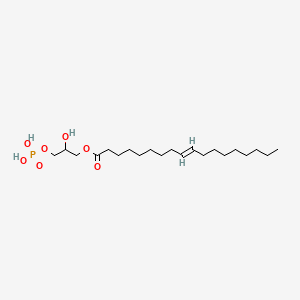| MeSH term | MeSH ID | Detail |
|---|---|---|
| Tuberculosis | D014376 | 20 associated lipids |
| Adenocarcinoma | D000230 | 166 associated lipids |
| Ovarian Neoplasms | D010051 | 10 associated lipids |
| Lung Neoplasms | D008175 | 171 associated lipids |
| Pulmonary Fibrosis | D011658 | 24 associated lipids |
| Pancreatic Neoplasms | D010190 | 77 associated lipids |
| Inflammation | D007249 | 119 associated lipids |
| Colonic Neoplasms | D003110 | 161 associated lipids |
| Diabetic Retinopathy | D003930 | 39 associated lipids |
| Mammary Neoplasms, Experimental | D008325 | 67 associated lipids |
lysophosphatidic acid
lysophosphatidic acid is a lipid of Glycerophospholipids (GP) class. Lysophosphatidic acid is associated with abnormalities such as Atherosclerosis, Alzheimer's Disease, Asthma, Diabetes Mellitus, Non-Insulin-Dependent and Septicemia. The involved functions are known as Inflammation, Chemotaxis, Binding (Molecular Function), Polymerization and Inflammatory Response. Lysophosphatidic acid often locates in Cytoskeleton, Microfilaments, actin cytoskeleton, Extracellular and Structure of germinal center of lymph node. The associated genes with lysophosphatidic acid are TNF gene, MAPK3 gene, RHOA gene, CDC42 gene and ADRBK1 gene. The related lipids are lysophosphatidic acid, Lipopolysaccharides, Lysophosphatidylcholines, Lysophospholipids and Phosphatidic Acid. The related experimental models are Knock-out, Transgenic Model, Rodent Model and Disease model.
Cross Reference
Introduction
To understand associated biological information of lysophosphatidic acid, we collected biological information of abnormalities, associated pathways, cellular/molecular locations, biological functions, related genes/proteins, lipids and common seen animal/experimental models with organized paragraphs from literatures.
What diseases are associated with lysophosphatidic acid?
lysophosphatidic acid is suspected in Atherosclerosis, Asthma, Dyslipidemias, Acute coronary syndrome, Pulmonary Fibrosis, Atherosclerosis of aorta and other diseases in descending order of the highest number of associated sentences.
Related references are mostly published in these journals:
| Disease | Cross reference | Weighted score | Related literature |
|---|
Possible diseases from mapped MeSH terms on references
We collected disease MeSH terms mapped to the references associated with lysophosphatidic acid
PubChem Associated disorders and diseases
What pathways are associated with lysophosphatidic acid
There are no associated biomedical information in the current reference collection.
PubChem Biomolecular Interactions and Pathways
Link to PubChem Biomolecular Interactions and PathwaysWhat cellular locations are associated with lysophosphatidic acid?
Visualization in cellular structure
Associated locations are in red color. Not associated locations are in black.
Related references are published most in these journals:
| Location | Cross reference | Weighted score | Related literatures |
|---|
What functions are associated with lysophosphatidic acid?
Related references are published most in these journals:
| Function | Cross reference | Weighted score | Related literatures |
|---|
What lipids are associated with lysophosphatidic acid?
Related references are published most in these journals:
| Lipid concept | Cross reference | Weighted score | Related literatures |
|---|
What genes are associated with lysophosphatidic acid?
Related references are published most in these journals:
| Gene | Cross reference | Weighted score | Related literatures |
|---|
What common seen animal models are associated with lysophosphatidic acid?
Knock-out
Knock-out are used in the study 'Source and role of intestinally derived lysophosphatidic acid in dyslipidemia and atherosclerosis.' (Navab M et al., 2015) and Knock-out are used in the study 'Lysophospholipid mediators in the vasculature.' (Mueller P et al., 2015).
Transgenic Model
Transgenic Model are used in the study 'Lysophosphatidic acid inhibits CD8 T cell activation and control of tumor progression.' (Oda SK et al., 2013).
Rodent Model
Rodent Model are used in the study 'Lysophosphatidic acid mediates fibrosis in injured joints by regulating collagen type I biosynthesis.' (Wu L et al., 2015).
Related references are published most in these journals:
| Model | Cross reference | Weighted score | Related literatures |
|---|
NCBI Entrez Crosslinks
All references with lysophosphatidic acid
Download all related citations| Authors | Title | Published | Journal | PubMed Link |
|---|---|---|---|---|
| Wang J et al. | Plasma lipidomic signatures of spontaneous obese rhesus monkeys. | 2019 | Lipids Health Dis | pmid:30621707 |
| Lei L et al. | The role of lysophosphatidic acid in the physiology and pathology of the skin. | 2019 | Life Sci. | pmid:30584899 |
| Lidgerwood GE et al. | Role of lysophosphatidic acid in the retinal pigment epithelium and photoreceptors. | 2018 | Biochim Biophys Acta Mol Cell Biol Lipids | pmid:29660533 |
| Sinderewicz E et al. | Expression of genes for enzymes synthesizing lysophosphatidic acid, its receptors and follicle developmental factors derived from the cumulus-oocyte complex is dependent on the ovarian follicle type in cows. | 2018 | Anim. Reprod. Sci. | pmid:29573844 |
| D'Souza K et al. | Lysophosphatidic Acid Signaling in Obesity and Insulin Resistance. | 2018 | Nutrients | pmid:29570618 |
| Jiang D et al. | Elevated lysophosphatidic acid levels in the serum and cerebrospinal fluid in patients with multiple sclerosis: therapeutic response and clinical implication. | 2018 | Neurol. Res. | pmid:29557721 |
| Hwang SU et al. | Lysophosphatidic acid increases in vitro maturation efficiency via uPA-uPAR signaling pathway in cumulus cells. | 2018 | Theriogenology | pmid:29554602 |
| Hidaka M et al. | Three lysophosphatidic acids with a distinct long chain moiety differently affect cell differentiation of human colon epithelial cells to goblet cells. | 2018 | Life Sci. | pmid:29412173 |
| Avula LR et al. | Both NHERF3 and NHERF2 are necessary for multiple aspects of acute regulation of NHE3 by elevated Ca, cGMP, and lysophosphatidic acid. | 2018 | Am. J. Physiol. Gastrointest. Liver Physiol. | pmid:28882822 |
| Tsukahara R et al. | LPA5 signaling is involved in multiple sclerosis-mediated neuropathic pain in the cuprizone mouse model. | 2018 | J. Pharmacol. Sci. | pmid:29409686 |
